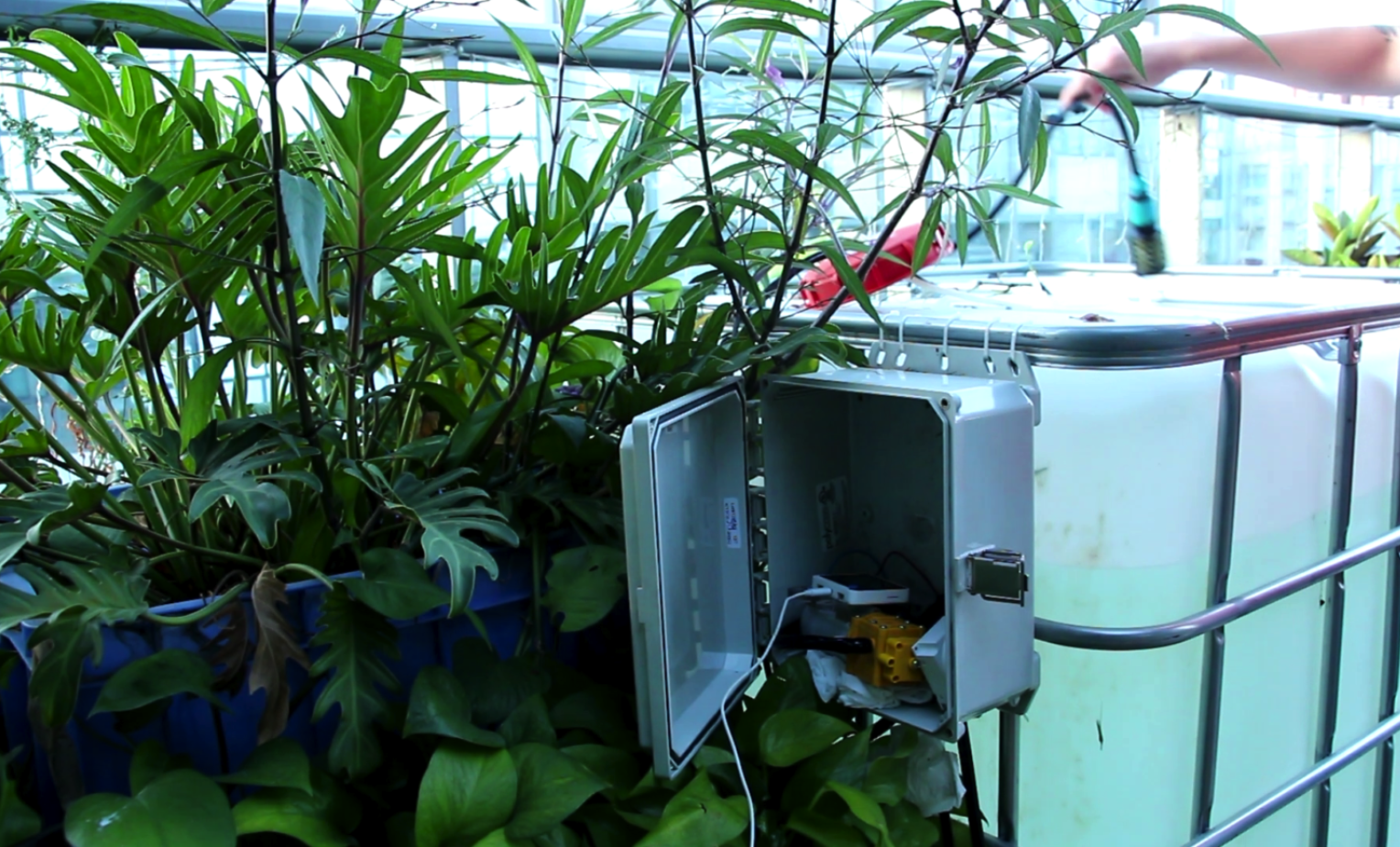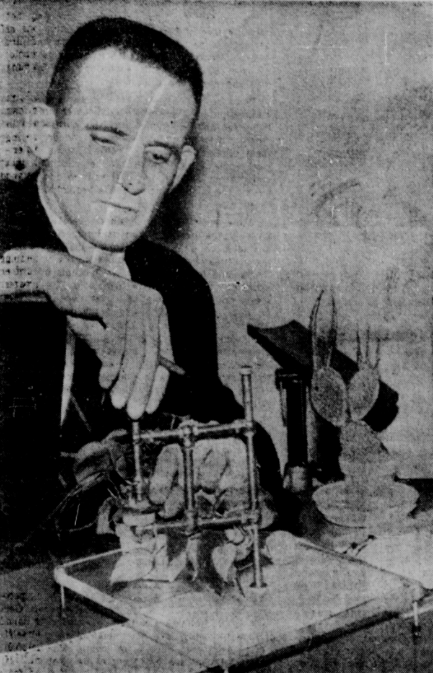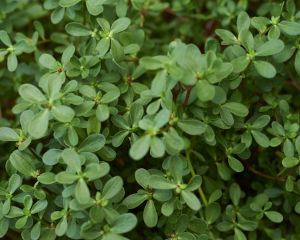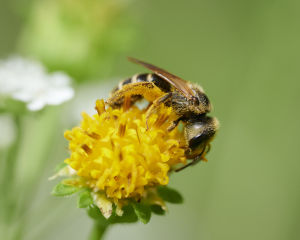
Listening to Plants, or Ourselves?
By Sam Stoeltje
Sign up for our monthly newsletter!
If you’ve come across an ad for Plantwave, you might have witnessed someone gently caressing a cactus or a sunflower while ambient synthesizer music seemingly “responds” to their touch. Upon clicking the ad, you’ll find that the Plantwave package comprises electrodes, the Plantwave app, and a Bluetooth speaker that may glow (though this remains unclear) in response to plant feedback. The app converts this feedback into musical sound by measuring electrical signals across the plant’s surface or surrounding soil, a process known as “sonification.”
This technique, also used by NASA to capture the “sound” of a black hole, renders non- audible, chaotic sounds as perceptible frequencies. There are no strict rules governing how an original signal is incorporated into the output of a process of sonification, something upon which Plantwave capitalizes. Users are allowed to assume, for instance, that the surface of a cactus produces pleasant-sounding chord changes following Western conventions of harmony. The Plantwave ads indicate the inherent ambiguity of collaboration—how much agency must an agent have in creating art, in this case, music? In this case, the actual chaotic biorhythms of the plant are heavily filtered through human expectations and conventions, making it challenging to hear the plant itself.
In attempting to listen to plants, what are we truly hearing? Plantwave reflects a post-social- media commodification of a history of human attempts to listen to and communicate with plants. This history spans from the C.I.A. through psychical research, conventional science, the New Age movement, to electronic music production. This is evident in Plantwave’s promotional copy, which offers a “sonic window into the secret life of plants,” referencing one the foundational texts of New Age plant mysticism, Peter Tompkins and Christopher Bird’s The Secret Life of Plants.
In 1966, a C.I.A. interrogation specialist named Cleve Backster, on a whim, hooked up a polygraph to the potted Dacaena fragrans in his office. Watching the readout, he had the idea to introduce a stimulus—more specifically, he considered burning one of the leaves—and watched as the needle jumped, measuring a galvanic skin response in the plant. Later experiments convinced Backster that, not only were plants conscious and sentient, but they were sensitive to the thoughts of other organisms. The Secret Life of Plants documents his forays, and those of a range of scientists into the possibilities, both reasonable and more outré, of plant consciousness. Written by former members of U.S. intelligence, the book indexes a period in the twentieth century when the boundaries between legitimate scientific research, murky pseudoscience, wild metaphysics, and the operations of secretive government organizations all coexisted and reinforced each other; a period that also encompassed research into the “mind control” potential of psychoactive substances like LSD, clairvoyance, and remote viewing.

Backster was not the first to speculate about plant consciousness, or to ascribe supernatural powers to plants. Instead, what The Secret Life of Plants narrates is the emergence of a desire for technological mediation between humans and plants and a belief that, through advanced technology, new avenues for communication with plants may become available.
(This belief has a kind of psychedelic “double” in the still-popular notion of communication with plants through altered states of consciousness, themselves often plant-, or fungus-, facilitated.) In this respect, among others, the book was ahead of its time. While telepathic abilities have yet to be convincingly documented in plants, we know now that they do respond to stimuli, that these responses are at least analogous to “pleasure” and “pain,” and that some plants can communicate with each other.1
The more outlandish claims, both Backster’s and those of The Secret Life of Plants, have yet to be born out. Rather than producing utilitarian applications in communication, interrogation, or surveillance, the book’s influence has been aesthetic. It likely helped to inspire Mort Garson’s early electronic record Mother Earth’s Plantasia, a small-batch release of compositions performed on a Moog synthesizer and distributed as a free bonus with the purchase of a houseplant from Mother Earth, a plant store in Los Angeles. Garson’s record announces itself, via subtitle, as “warm earth music for plants and the people that love them,” partaking of the idea (asserted in The Secret Life of Plants) that plants not only enjoy music but respond positively to it.
In 1979, The Secret Life of Plants was adapted as a documentary feature titled “Journey Through the Secret Life of Plants.” Although not intended for a vegetal audience, Stevie Wonder’s soundtrack for the feature film also featured cutting-edge electronic instruments. If Plantasia represents a human’s perception of what plants might enjoy—warm, friendly, almost lullabies—Wonder’s compositions offer a human interpretation of what plants could sound like– alien, uncanny, yet filtered through the impulses of melody and repetition one would expect from a pop songwriter. In both cases, Garson and Wonder seem to share the notion that new technology, particularly synthesizers, is crucial for bridging the gap between humans and plants.
Intriguingly, Backster’s techniques have resurfaced in the 21st century, a time when the polygraph test has been largely discredited for its original purpose, and its component technologies have taken on a retrograde, even nostalgic aura. Before the viral success of Plantwave, avant-garde performers and composers revisited the electrode, combining it with algorithmic sonification to collaborate with the electric impulses coursing through roots, stems, leaves, and soil. Some of these artists possess sophisticated understandings of plant biology, creating remarkable recordings. The English sound composer Mileece, who has created works such as Sonic Garden, an installation that allows the audience to touch and interact with the plants and their biosignals, said, “I do think plants are sentient. I know they are sentient… consciousness is derived from having a central processing unit, as in the brain, which plants do not have. However, they have conglomerations of tiny cells that function like brains—assessing, making decisions, and updating information in real-time.”
In “The Secret Life of Plants,” Cleve Backster aimed to use plants as part of a circuit with polygraph technology to facilitate communication among humans. However, musicians inspired by his research took a different approach, using technology to listen to plants. Since what plants “say” is a fundamentally chaotic response to their environment, these composers face the challenge of deciding how much mediation and idiomatic control to employ in translating these utterances into audible sounds. In the pursuit of mass appeal, endeavors like Plantwave opt for maximum mediation, convincing a broad consumer base that they are hearing spontaneous music from plant performers, resembling new age electronic music. In a sense, Plantwave, encapsulates both the positive and negative facets of the New Age movement: the idea of an awestruck and reverential connection with the nonhuman, transformed into a mass-produced and misguided consumer experience—with the secret life of plants still concealed yet commodified.
Sam Stoeltje, PhD, is a professor at Utica University. They specialize in Religious Studies, Critical and Decolonial Theory, and Epistemic Justice.
Plantings
Issue 29 – November 2023

Viriditas: Musings on Magical Plants: Portulaca oleracea
By Margaux Crump

Proboscis, Pollen, and the Rapture of Interspecies Intimacy
By Jake Eshelman

The Greening of Milan: Porta Nuova and Vertical Forest
By Gayil Nalls

Overshooting Earth’s Boundaries: An Interview with Bill Rees
By Rachel Donald

The Garden of the Five Senses
By Gayil Nalls

Eat More Plants Recipes:
Le Botaniste’s Fennel, Tomato, and Red Pepper Pasta Sauce

As Ireland transitions from the rich, smoky scent of peat-burning to a more sustainable future, its olfactory heritage is evolving. What will become the next iconic aromatic symbol of Ireland?
Click to watch the documentary trailer.


